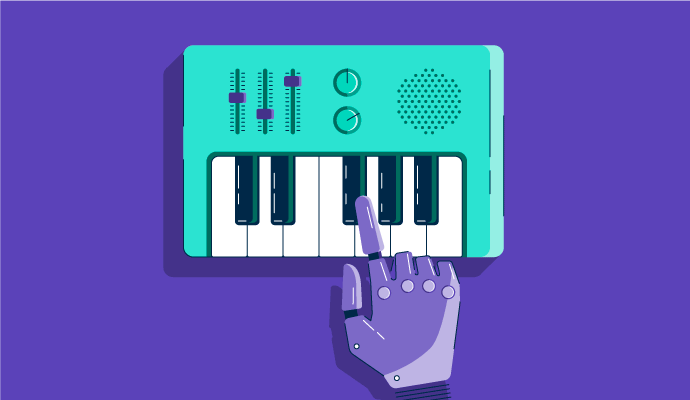What is synthetic media? Types, benefits and best practices
Is there anything we do that doesn't involve the media?
Scrolling through social media apps, listening to music, watching TV, working: media surrounds us. We consume more content than previous generations could have imagined, and new technologies allow us to actively participate in its creation.
Now anyone can design a beautiful website, edit on TikTok, compose music, or apply a hilarious Snapchat filter to their vacation videos.
So what's facilitating this revolution in content creation?
As computers get smarter, producing content requires less and less of our human involvement. The result of this is synthetic media, a form of artificially generated media.
Tools such as synthetic media software can create artificial intelligence (AI)-generated music, text, images, and speech synthesis. As synthetic media companies attempt to disrupt outdated aspects of traditional media, it becomes simpler to create new works.
What is synthetic media?Synthetic media is a new type of virtual media created using artificial intelligence (AI). A high degree of realism and immersion sets it apart from other forms of traditional media.
Synthetic media is an umbrella term for the artificial production, manipulation, and modification of data and media by automated means in order to deceive or alter their original purpose. Changes are often made using AI algorithms.
Our methods of communication have always been inextricably linked to the technologies available at the time. Right now, we are witnessing constant advances in technology, which lead to new methods of communication, such as new media formats that differ in creation, consumption and contextualization.
As more companies realize the full potential of synthetic media, their use will radically revolutionize many industries and applications, with astonishing results.
is the projected value of the global synthetic media market by 2027.
Source: 360iResearch
How do synthetic media work?Generative AI is the technology behind the production of synthetic media, which is why the two terms are often used interchangeably. Today, many AI applications are enabled by deep learning and generative adversarial networks (GANs) that teach computers to think like humans and make intelligent decisions.
GANs allow computers to generate realistic content. It's powered by two neural networks: one that creates fake images from real photographs, and the other that acts as a judge to determine if an image is genuine.
GAN outputs often look natural and indistinguishable from the original images. Therefore, they allow the creation of synthetic media that are difficult to distinguish from real media, especially in computer vision and image processing applications.
Synthetic Media vs Non-Synthetic MediaSynthetic media are constructed partially or entirely by computers. Non-synthetic media is all other conventionally made media, that is, media created with human intervention.
Think of two specific cases.
First, a newspaper article. It is a non-synthetic form of media because someone (a human) wrote it. Next, consider an image in which an Instagram filter has been used to add bunny ears to a natural human face. Since the AI primarily created it, the media is considered synthetic.
Types of synthetic mediaEvery day, Fortune 500 companies and independent producers turn to AI-generated content. Some well-known forms of synthetic carriers are described below.
Text-based synthetic media generates written content using machine learning (ML) software and AI algorithms. Synthetic text-based media uses natural language processing (NLP) tools to generate coherent, relevant, human-like text based on input data or prompts provided by the user. Audio-based system...
Is there anything we do that doesn't involve the media?
Scrolling through social media apps, listening to music, watching TV, working: media surrounds us. We consume more content than previous generations could have imagined, and new technologies allow us to actively participate in its creation.
Now anyone can design a beautiful website, edit on TikTok, compose music, or apply a hilarious Snapchat filter to their vacation videos.
So what's facilitating this revolution in content creation?
As computers get smarter, producing content requires less and less of our human involvement. The result of this is synthetic media, a form of artificially generated media.
Tools such as synthetic media software can create artificial intelligence (AI)-generated music, text, images, and speech synthesis. As synthetic media companies attempt to disrupt outdated aspects of traditional media, it becomes simpler to create new works.
What is synthetic media?Synthetic media is a new type of virtual media created using artificial intelligence (AI). A high degree of realism and immersion sets it apart from other forms of traditional media.
Synthetic media is an umbrella term for the artificial production, manipulation, and modification of data and media by automated means in order to deceive or alter their original purpose. Changes are often made using AI algorithms.
Our methods of communication have always been inextricably linked to the technologies available at the time. Right now, we are witnessing constant advances in technology, which lead to new methods of communication, such as new media formats that differ in creation, consumption and contextualization.
As more companies realize the full potential of synthetic media, their use will radically revolutionize many industries and applications, with astonishing results.
is the projected value of the global synthetic media market by 2027.
Source: 360iResearch
How do synthetic media work?Generative AI is the technology behind the production of synthetic media, which is why the two terms are often used interchangeably. Today, many AI applications are enabled by deep learning and generative adversarial networks (GANs) that teach computers to think like humans and make intelligent decisions.
GANs allow computers to generate realistic content. It's powered by two neural networks: one that creates fake images from real photographs, and the other that acts as a judge to determine if an image is genuine.
GAN outputs often look natural and indistinguishable from the original images. Therefore, they allow the creation of synthetic media that are difficult to distinguish from real media, especially in computer vision and image processing applications.
Synthetic Media vs Non-Synthetic MediaSynthetic media are constructed partially or entirely by computers. Non-synthetic media is all other conventionally made media, that is, media created with human intervention.
Think of two specific cases.
First, a newspaper article. It is a non-synthetic form of media because someone (a human) wrote it. Next, consider an image in which an Instagram filter has been used to add bunny ears to a natural human face. Since the AI primarily created it, the media is considered synthetic.
Types of synthetic mediaEvery day, Fortune 500 companies and independent producers turn to AI-generated content. Some well-known forms of synthetic carriers are described below.
Text-based synthetic media generates written content using machine learning (ML) software and AI algorithms. Synthetic text-based media uses natural language processing (NLP) tools to generate coherent, relevant, human-like text based on input data or prompts provided by the user. Audio-based system...What's Your Reaction?















![Three of ID's top PR executives quit ad firm Powerhouse [EXCLUSIVE]](https://variety.com/wp-content/uploads/2023/02/ID-PR-Logo.jpg?#)







